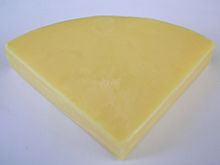Dunlop (cheese)
Dunlop cheese is a hard Scottish cheese . Its origins date back to the late 17th century. Its production peaked in the late 19th century until around 1930. After the Second World War it was only made by a few cheese factories .
history
According to tradition, a Scottish woman from what was then Parish Dunlop in East Ayrshire , Barbara Gilmour, brought the recipe and the production technique with her when she returned from Ireland . She was previously in exile in Ulster for religious reasons . The events are said to have occurred around 1690 or shortly afterwards. The method of production, in particular the use of milk with the full cream content without skimming it off beforehand, and the pressing of the cheese were previously unknown in Scotland. Because of the changed taste through this production, the Dunlop was also called sweet milk cheese or new milk cheese . The new method of production was soon copied, and around 1790 the cheese was already being made in two parishes in neighboring Lanarkshire . As the population increased as a result of industrialization in Scotland, cheese became more widespread, especially in the late 19th century. Around 1930 the cheese was being produced by around 300 companies. After the Second World War, production almost came to a standstill. Only a few dairies, including those on the Isle of Arran , continued production.
Production and taste
The production corresponds to the normal production method of a hard cheese, whereby the milk during the production of this cheese may only be heated to a temperature of 36.5 degrees Celsius . After rubbing the loaf with salt, the cheese matures for at least six to eight weeks up to six months. Dunlop must not contain more than 44% water. In a book from the first quarter of the 19th century we can read that on the one hand fresh milk was used in the production and on the other hand milk that had stood for twelve hours. The same source also mentions that some manufacturers annatto used to English to imitate cheese. The taste is described as nutty, compared to cheddar as milder and creamier, only spicy with mature cheese. The mouthfeel is also described as being softer than that of cheddar.
literature
- Alan Davidson, Tom Jaine: The Oxford companion to food. Oxford University Press, Oxford 2006, ISBN 0-19-280681-5 .
- R. Scott, Richard Kenneth Robinson, R. Andrew Wilbey: Cheesemaking practice , Kluwer Academic / Plenum Publishers, New York 1998, ISBN 0-7514-0417-9 .
- Josiah Twamley: Essays on the management of the dairy: including the modern practice of the best districts in the manufacture of cheese and butter , J. Harding, London 1816.
Individual evidence
- ^ A b c d e Alan Davidson, Tom Jaine: The Oxford companion to food. , P. 263.
- ^ A b R. Scott, Richard Kenneth Robinson, R. Andrew Wilbey: Cheesemaking practice , p. 206.
- ↑ a b Josiah Twamley: Essays on the management of the dairy: including the modern practice of the best districts in the manufacture of cheese and butter , p. 143.
